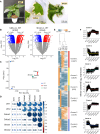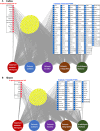Elucidating the callus-to-shoot-forming mechanism in Capsicum annuum 'Dempsey' through comparative transcriptome analyses
- PMID: 38711041
- PMCID: PMC11075324
- DOI: 10.1186/s12870-024-05033-4
Elucidating the callus-to-shoot-forming mechanism in Capsicum annuum 'Dempsey' through comparative transcriptome analyses
Abstract
Background: The formation of shoots plays a pivotal role in plant organogenesis and productivity. Despite its significance, the underlying molecular mechanism of de novo regeneration has not been extensively elucidated in Capsicum annuum 'Dempsey', a bell pepper cultivar. To address this, we performed a comparative transcriptome analysis focusing on the differential expression in C. annuum 'Dempsey' shoot, callus, and leaf tissue. We further investigated phytohormone-related biological processes and their interacting genes in the C. annuum 'Dempsey' transcriptome based on comparative transcriptomic analysis across five species.
Results: We provided a comprehensive view of the gene networks regulating shoot formation on the callus, revealing a strong involvement of hypoxia responses and oxidative stress. Our comparative transcriptome analysis revealed a significant conservation in the increase of gene expression patterns related to auxin and defense mechanisms in both callus and shoot tissues. Consequently, hypoxia response and defense mechanism emerged as critical regulators in callus and shoot formation in C. annuum 'Dempsey'. Current transcriptome data also indicated a substantial decline in gene expression linked to photosynthesis within regenerative tissues, implying a deactivation of the regulatory system governing photosynthesis in C. annuum 'Dempsey'.
Conclusion: Coupled with defense mechanisms, we thus considered spatial redistribution of auxin to play a critical role in the shoot morphogenesis via primordia outgrowth. Our findings shed light on shoot formation mechanisms in C. annuum 'Dempsey' explants, important information for regeneration programs, and have broader implications for precise molecular breeding in recalcitrant crops.
Keywords: Capsicum annuum; Auxin redistribution; Bell pepper ‘Dempsey’; Defense mechanism; Hypoxia; Regeneration; Shoot formation; Transcriptome.
© 2024. The Author(s).
Conflict of interest statement
The authors declare no competing interests.
Figures






Similar articles
-
Leaf-induced callus formation in two cultivars: hot pepper 'CM334' and bell pepper 'Dempsey'.Plant Signal Behav. 2019;14(7):1604016. doi: 10.1080/15592324.2019.1604016. Epub 2019 Apr 13. Plant Signal Behav. 2019. PMID: 30983498 Free PMC article.
-
A stable DNA-free screening system for CRISPR/RNPs-mediated gene editing in hot and sweet cultivars of Capsicum annuum.BMC Plant Biol. 2020 Oct 1;20(1):449. doi: 10.1186/s12870-020-02665-0. BMC Plant Biol. 2020. PMID: 33004008 Free PMC article.
-
Agrobacterium-Mediated Capsicum annuum Gene Editing in Two Cultivars, Hot Pepper CM334 and Bell Pepper Dempsey.Int J Mol Sci. 2021 Apr 10;22(8):3921. doi: 10.3390/ijms22083921. Int J Mol Sci. 2021. PMID: 33920210 Free PMC article.
-
Integrating the Roles for Cytokinin and Auxin in De Novo Shoot Organogenesis: From Hormone Uptake to Signaling Outputs.Int J Mol Sci. 2021 Aug 9;22(16):8554. doi: 10.3390/ijms22168554. Int J Mol Sci. 2021. PMID: 34445260 Free PMC article. Review.
-
De novo shoot organogenesis during plant regeneration.J Exp Bot. 2020 Jan 1;71(1):63-72. doi: 10.1093/jxb/erz395. J Exp Bot. 2020. PMID: 31504722 Review.
References
-
- Shu H, Zhang Y, He C, Altaf MA, Hao Y, Liao D, Li L, Li C, Fu H, Cheng S, et al. Establishment of in vitro regeneration system and molecular analysis of early development of somatic callus in Capsicum chinense and Capsicum baccatum. Front Plant Sci. 2022;13:1025497. doi: 10.3389/fpls.2022.1025497. - DOI - PMC - PubMed
Publication types
MeSH terms
Substances
Grants and funding
LinkOut - more resources
Full Text Sources

